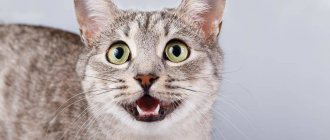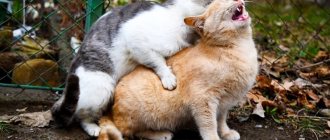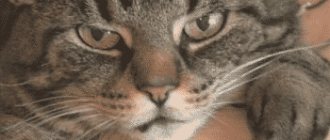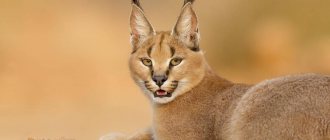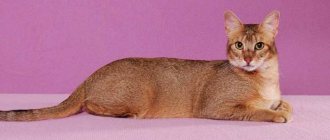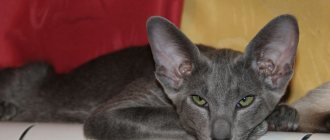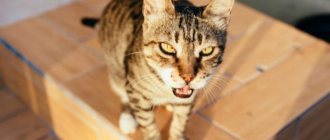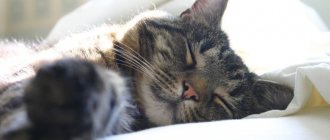Interesting facts from the life of animals
The lynx is a typical cat, about the size of an adult large dog with its tail cut off. You can meet her in the taiga or forest, but she is so careful that very few succeed.
Such a lynx is unlikely to be suitable for domestic conditions, although today there are cases where the taming of a lynx has become a completely successful event.
Domestic lynx
differs from its wild relative, as it belongs to an artificially bred breed, which was developed by crossing small wild breeds of lynx with ordinary cats of a suitable color. It is worth noting that they are still working on breeding a real domestic lynx.
Domestic lynxes have the appearance of a real Canada lynx, namely, a strong and flexible body, long legs and pronounced muscles, thick and short hair, a wide nose and almond-shaped eyes. As for the size of the domestic lynx, it is about half the size of the wild lynx that can be seen in the zoo or on TV.
Many cat lovers wonder what breeds of lynx exist that can be kept at home. Particular attention is paid to such a domestic species as the caracal.
Caracal - domestic lynx
, which can become an absolutely harmless pet, but on the condition that it will grow up in captivity from childhood under the careful care of its owners. Caracal requires special attention and special conditions for keeping.
It will be good if a spacious enclosure is built for the pet animal, where it can walk freely and sharpen its claws. To do this, you will need to choose a place for an enclosure with a growing tree or, after building it, plant a young tree.
Or build a special structure from boards.
You need to start training a caracal from childhood; caracal kittens are the best to train. If you decide to adopt an adult animal, then think a hundred times before such an important step, since an adult caracal is unlikely to become so obedient.
How to keep a lynx at home and what to feed
Lynx at home
– this is a very serious step that should be taken with full responsibility and well prepared. First of all, you need to understand that keeping a lynx at home is quite a troublesome task and requires time and money from the owners.
Not to mention that it is not difficult to buy a domestic lynx today, but quite expensive. You can feed a lynx the same way as a regular domestic cat, but you won’t be able to get by with dry food alone.
Lynx requires regular consumption of meat and fish, and the diet must also contain bones, which will provide stress on the jaw muscles.
It is worth noting that a lynx, like a cat, swallows fur when licking and often choke on it. Therefore, owners should regularly care for the cat's fur and systematically comb it.
When asked if lynx is dangerous
, it is impossible to answer unambiguously.
The wild lynx is a predator and can be dangerous to keep at home.
Expert opinion Smirnov Alexander Stanislavovich Wilderness survival instructor. More than 15 years of teaching experience
An artificially bred domestic lynx can become a very interesting, trainable and friendly pet. But still, it is not recommended to have a lynx at home where there are small children.
Although this type of cat has predatory instincts hidden deeply and is a completely harmless animal in appearance, there is no guarantee that something irreparable could happen if these instincts are awakened.
Lynx-like felines that can live with humans
Lynxes are not the only representatives of the family with long hairs on their ears and camouflage coat color. Among wild relatives, caracals and jungle cats have the greatest external resemblance to the famous predator. They also live in the wild, but can live with humans. However, for their maintenance it is necessary to create conditions close to the natural environment.
Caracal - steppe lynx
The caracal is called the steppe lynx. Wild caracals are found in Africa, Central Asia, the Middle East, and in some areas of Turkmenistan, Kyrgyzstan, Uzbekistan and Dagestan.
Caracal
Caracals have a slimmer build and weigh 11–12 kg. The tall, straight ears have distinct, long dark hairs. The steppe lynx's fur is dense, short, and has hard bristles on its paws. A distinctive feature of the caracal is its reddish coat without spots. In addition, the animal has a fairly long tail, growing up to 30 cm.
Baby caracals
Kittens born in the wild will not be able to become pets. Only animals born from individuals kept in captivity can live with humans. It is better to keep domesticated caracals on the territory of country houses, where they will have the opportunity to move freely over a large area.
When keeping a caracal at home, special attention should be paid to nutrition. A predator's diet must include raw meat, poultry, and eggs. Some owners of these exotic pets feed them premium or super-premium dry ready-made food
Some owners of these exotic pets feed them premium or super-premium dry ready-made food.
It is not recommended to have caracals in a house where there are small children.
A predator has very strong natural instincts, so if handled carelessly, he can quickly hit back at the offender
Jungle cat - marsh lynx
People were able to tame the jungle cat 3 thousand years ago. The people of Egypt were the first to do this. They called it house, which meant "house", because the animals lived in people's houses. Another nickname for the animal is the swamp lynx. These animals do not like to go out into open areas. They live in reed thickets, among bushes growing on the banks of water bodies, and often hunt for fish and waterfowl. Animals visit human settlements only when there is a lack of food. They raid chicken coops.
jungle cat
Populations of these predators are mainly found in regions with warm climates. They live in Africa, Central Asia, the Caucasus, and also live in India, Palestine, and Thailand. In Russia, animals can be seen on the Volga coast and in Dagestan.
This predator is similar to a lynx in the color of its coat, but is smaller in size. The body length of the jungle cat is about 90 cm, the weight of the largest individuals reaches 12 kg, the height at the withers does not exceed 0.5 m. Small spots on the body are almost invisible in adult individuals, they are more pronounced in kittens.
The jungle cat becomes a pet only in exceptional cases. Developed natural instincts make it dangerous even for the owner who has lived nearby since childhood.
You can keep a swamp lynx in an area where it can freely hunt, swim and walk. The proximity of other pets to a wild cat is unacceptable.
How much does a live domestic lynx cost in Russia?
There are many species of wild cat. Let's look at the prices for the main ones.
- Red lynx, or red – 50 thousand rubles.
- Canadian – 40 thousand rubles.
- Ordinary – 100 thousand rubles.
- Pyrenean, or Spanish - it is not possible to buy legally, as it is listed in position 1 of CITES.
Meanwhile, wild species are difficult to domesticate. Thanks to crossbreeding, breeds have been developed that are characterized by a gentle disposition and good tamability. Naturally, this could not but affect the price aspect.
- Steppe lynx, or caracal – 400 thousand rubles. Due to the noticeable external similarity, this animal was classified as a lynx species, but today it belongs to a separate genus. If raised correctly, these kittens turn into playful and friendly adult pets.
- Karaket – from 850 thousand to 1 million rubles. This species was the result of mixing a domestic cat with a caracal. This is a rather peaceful, friendly breed, sometimes very independent, but not at all aggressive. A hybrid belonging to the first generation is more valued, the cost of which often exceeds 1 million rubles. By the way, the caracat is more similar to the lynx.
- Domestic lynx - from 400 thousand to 1 million rubles. These representatives are a cross between a domestic cat and a Canadian lynx. In appearance it is similar to its wild ancestor, but from the domestic cat the lynx got its active character, tenderness and love for humans.
Keeping such pets does not require a huge amount of space, and there are no risks associated with living with a wild animal. For how many rubles you can purchase such representatives, we will consider further.
- Siberian cat – from 7 to 15 thousand rubles. This little beauty was the result of a love for wild cats that lived in the Trans-Urals and oriental breeds. The thick coat is due to the harsh climate. The tassels on the ears resemble wild relatives. A characteristic feature of this breed, in addition to its complacent disposition, is attachment to only one owner.
- Norwegian forest - from 12 to 70 thousand rubles. and more. Their large size and powerful stature should not frighten you, because these Norwegian cats have a kind and reserved disposition. By the way, they are ready to get along with noisy children and with other tribesmen, for example, with dogs.
- Pixie bob – from 30 to 100 thousand rubles. This breed is quite young and rare. These cats have a canine character, are very smart, and calm. They tolerate change negatively, and without human contact they can quickly become wild.
- Maine Coon - from 20 to 80 thousand rubles. One version says that such pets were the result of mating between an ordinary cat and a North American lynx.
- Kurilian bobtail – from 15 to 70 thousand rubles. These wonderful animals were bred on the Kuril Islands. This breed is perfect for someone who is looking for a fun and smart animal.
- American bobtail – from 35 to 90 thousand rubles. This species is very loving, characterized by ingenuity and intelligence. For example, these cats will have no difficulty leaving a closed cage.
Summarizing
Table. Comparison of cat breeds similar to lynxes
| Dimensions, weight | Cost of a kitten | Character | |
| Caracal | Weight up to 25 kilograms, at the withers up to half a meter. | From 600 thousand rubles to 1.5 million | Can be aggressive |
| Caraquet | Weight up to 15 kilograms, at the withers up to 40 centimeters. | From 500 thousand to 1.2 million rubles | An experimental breed in which breeders are trying to get rid of aggression |
| Maine Coon | Weight up to 15 kilograms, at the withers up to 35 centimeters. | 30-70 thousand rubles | Affectionate but capricious |
| Bobtail USA | Weight up to 9 kilograms, at the withers up to 30 centimeters. | 25-50 thousand rubles | Gentle, obedient |
| Norwegian forest | Weight up to 10 kilograms, at the withers up to 30 centimeters. | 25-50 thousand rubles | Independent, friendly |
| Pixie bob | Weight up to 8-9 kilograms, at the withers up to 25 centimeters. | 50-100 thousand rubles | Phlegmatic, calm, flexible |
A person who likes the appearance of a wild lynx may well have a miniature pet. There are several breeds of cats that are more or less similar to lynxes. Therefore, choose a pet that will please the eye, but not burden your wallet and everyday life.
Hybrids
Caraquet
Caracats are a “kind” copy of caracals, the fruit of love between a representative of the latter and an Abyssinian cat. For a long time, breeders suffered defeats in their attempts to breed hybrid offspring capable of reproducing. Our compatriot from Krasnodar was able to succeed in this at the end of the 20th century. Thanks to her, this mixture of cat and steppe lynx combines wild beauty and gentle disposition.
The conformation of this new breed of lynx-like cat is identical to the caracal: the same body size, coat color, long hind legs and ear tufts. However, their character is much calmer and more peaceful than that of their wild ancestors. They love to play and get along well with their pet neighbors.
Caracats are easy to train to walk in a harness. They also need a well-equipped playground that satisfies their wild instincts.
Domestic lynx
Thanks to the efforts of breeders, crossing the Canadian lynx with domesticated cats with spotted skins gives us the opportunity to have a real lynx, only a domestic one. She has the same long hind legs, shortened tail, graceful curve of the spine, expressive almond-shaped eyes and “signature” ear tufts.
Individuals of the domestic lynx have thick gray-brown fur. Lynxes are incredibly beautiful, their fur has a gray-blue tint - it seems as if they have just rolled out in the snow.
Such a luxurious fur coat requires constant and thorough combing. Otherwise, the animal runs the risk of choking when licking
In general, caring for a domestic cat-lynx hybrid is identical to caring for a caracal or caraquet - a lot of movement, raw meat and constant attention
Caracal
The caracal is very similar in appearance to the lynx, but is slightly smaller in size. Just like the lynx, the caracal has dense, thick fur, lush dark tufts on the tips of the ears, and coarse bristly hair on the paws. It has a uniform red color with a whitish lower part. Melissas are rarely found - individuals with black coat color.
The caracal is a predatory animal, the original purpose of domestication was to help in hunting. Nowadays this exotic animal is purchased as a pet. Caracals are balanced and energetic. They are characterized by a love of games and affection, and curiosity.
The price varies from 400 to 500 thousand rubles.
You need to buy a pet at the age of 4-6 years and only in specialized nurseries.
If you buy at the market or on the Internet, there is a chance that you will purchase an animal that was caught in the wild and not accustomed to home conditions.
Such individuals are predatory and do not live at home.
Caracal
Grace and grace of the lynx
In nature, the lynx is a separate population of mammals, which in appearance is most similar to the cat population itself. Its dimensions do not exceed those of a large dog, which it slightly resembles with a short body and long legs. Lynxes are great at climbing rocks and trees. Its elongated hind legs, overgrown with hair in winter, help the animal to grip well on loose snow. A rather short tail does not prevent the lynx from moving through trees and mountains in the forest.
Lynxes live in the forests of central Russia, some European countries, the USA, Canada, Central Asia, as well as in the Scandinavian countries. The body length can reach up to 1.30 m, the height at the withers can be up to 0.7 m, and the weight varies from 5 to 30 kg. The coloring of these predators is quite varied: red, brown, smoky, etc. Characteristic features of the lynx: elongated hind legs, a small tail, and specific tufts on the ears.
Diet
Like all felines, the Lynx is a specialized predator that hunts mainly small and medium-sized mammals and birds.
Recorded prey species for this species include hares, rabbits, marmots, squirrels, dormouse, wolverines and other rodents, midgets (e.g. martens, sables, weasels), grouse birds (grouse, grouse, hazel grouse), fox, wild boar, chamois, young elk, roe deer, common and northern deer, musk deer, goral and other ungulates. Although hunting larger animals poses dangers to the animal, the size of the kill often outweighs the risks.
Thus, the Eurasian Lynx prefers rather large ungulate prey, especially in winter, when small animals are few in number.
This is the only species of Lynx in which ungulates make up the majority of the diet in relation to lagomorphs (rabbits, hares) or rodents.
Where roe deer are found, they are the cat's preferred prey species. Otherwise, deer will be the favorite food, although in summer predators eat smaller animals and sometimes domestic sheep quite regularly.
In some areas of Finland, the main diet of the Common Lynx is white-tailed deer, in Poland and Austria it is red, in Switzerland it is more likely to be chamois.
Wild cats can, if necessary, feed on carrion if other types of prey are not available, although they prefer fresh animal meat.
Adults require 1.1 to 2 kg of meat per day, and it may take several days for the animal to fully consume at least part of its larger prey. The predator catches hares and rabbits once every two to three days, but for a female with a litter this is the daily norm.
An animal can spend a week near the carcass of a deer or roe deer, burying what it has not eaten in the snow, the ground, or covering it with grass, and it does this so carelessly that such hiding places are often found by sables and weasels.
This successful hunter is often followed by wolverines, who are not even afraid to drive away a predator from a fresh carcass. He chases the Lynx from his hunting territory and foxes.
In winter, heavy snow cover in the northern habitat complicates the situation, and the animal may be forced to switch to larger prey.
Eurasian Lynxes hunt using both sight and hearing, and will often climb onto tall rocks or fallen trees to survey their surroundings.
Being a very strong predator, these animals successfully kill adult deer weighing at least 150 kg.
The lynx is usually a solitary hunter, although a small group of individuals may sometimes move around and hunt together.
The northern subspecies prefer hunting in dense coniferous forests, occasionally wandering into the forest-steppe and forest tundra. In addition to excellent acrobat skills, this cat is an excellent swimmer and fisherman.
In winter, she is not bothered by the snow cover, since the special structure of her paws allows her to move easily without falling into the crust.
In the cold season, the beast can attack domestic animals, including cats and dogs, and is also not disdainful of raccoons and foxes. However, the predator always kills foxes and martens, even if he is not hungry.
Humans do not scare this animal; there are no cases of Lynx tracking or attacking people.
Domestic lynx and its features
The domestic lynx is also an artificial breed. She was bred by crossing a domestic cat with a Canadian wild cat. As in the case of the caraquet, breeding work regarding the domestic lynx continues to this day.
Breeders strive to ensure that the animals are healthy and visually attractive, and that such domestic lynxes can be kept at home.
The domestic lynx cat is a rare and difficult breed to reproduce. Accordingly, it is also expensive. Such a high price is due to complex breeding work. For the result to be successful, breeders need a lot of time. These cats should look like a real wild lynx, but at the same time have a gentle character, like a pet.
Domestic lynxes are very good-natured. Their key external features are as follows:
- the physique is strong, the skeleton is well developed;
- the body has a rectangular shape, the back is arched;
- the tail is short and mobile;
- limbs are oblong;
- wide nose;
- the head is triangular, cheekbones are raised;
- almond-shaped eyes;
- The coat is short and thick.
Domestic lynx are incredibly similar to wild ones, but domestic pets are smaller in size. This is a consequence of the fact that Canadian lynxes, which are recognized as the smallest species of these wild animals, participated in the selection.
Features of caring for a domestic lynx or caraquet
Despite the fact that these breeds are called domestic, we must not forget that the blood of wild predators flows in their veins. It is strictly forbidden to feed such a pet dry store-bought food. These cats constantly need fresh meat in large quantities, and in order to give exercise to their developed jaws, they should be given sinews and bones. Nutrition should be balanced. These pets are constantly moving and incredibly active, so provide them with space to do this.
For preventive purposes, to prevent an animal from swallowing fur, it should be combed regularly and sometimes give pets products to prevent the accumulation of hairballs in the internal organs. Be sure to provide your pet with the following:
- active games;
- walks;
- bathing.
Caracal
A cat with an unusual appearance, the breed of which is translated from Turkish as “black ear”. The caracal has a slender, graceful body. The average weight of the animal is 11–19 kg. When you first look at a cat, the head seems unnaturally small against the backdrop of the massive body. There are black markings around the expressive almond-shaped eyes. A distinctive feature of the appearance of the domestic lynx is its erect ears with black tassels. Representatives of the breed have short, thick, sand-colored fur with a brown or reddish tint.
Despite the harsh appearance that the cat inherited from its wild ancestors, its character is soft, so it is becoming popular to keep them at home. They get along easily with people and other animals. Caracal prefers to always be in the center of attention and loves to watch a person’s actions.
Experts advise against buying a caracal if there are children under five years old in the house.
This is important because children do not have the skills to communicate with pets.
The first rule in caring for a cat is to brush its fur once a week. It is necessary to bathe your pet as needed; do not overuse water procedures. Sometimes you can draw a bath for the caracal to swim in, this will give him pleasure
It is very important to provide active physical activity. To do this, you need to walk your cat in the fresh air every day. Proper balanced nutrition is the basis of health and longevity
Therefore, it is necessary to include meat, fish and eggs in the diet. If you follow all the rules for caring for an animal, it will delight its owners for a long time.
Proper balanced nutrition is the basis of health and longevity. Therefore, it is necessary to include meat, fish and eggs in the diet. If you follow all the rules for caring for an animal, it will please its owners for a long time.
Cat breeds that are similar to wild relatives - list, photos and characteristics
Having wild cats such as lynx, leopard, puma or tiger as a pet is not a good idea, but throughout history people have tried to domesticate servals, caracals, fishing cats, ocelots, cheetahs and even lions. The desire to own a wild animal can have very negative consequences, so breeders have used their skills to breed cat breeds that are similar to wild ones, but at the same time safe for their owners.
From the striking Bengal to the unusual Savannah, meet our selection of ten cat breeds that have only wild looks, but not character.
Abyssinian cat
Due to its unique ticked coat color, the Abyssinian cat is very similar to African wild cats. Ticking is alternating light and dark patches on each hair shaft. In addition to their beautiful fur coat, representatives of this breed stand out for their playfulness, high level of intelligence and energetic nature.
Bengal cat
Do you want a breed with the appearance of a leopard and the demeanor of a house cat? Then, without a doubt, get a Bengal cat, bred by crossing domestic and wild Bengal cats. Bengals have stunning coat colors that come in a variety of vibrant patterns: rosettes, spots, or even merle patterns (where one or more colors are mixed into the base coat color).
Bombay
If you do not take into account the calm, patient and friendly nature of the Bombay, you might think that he is a miniature copy of the black panther. The breed's exotic appearance was achieved by crossing a sable Burmese cat with a black American Shorthair, earning it the nickname "the patent leather baby with the new penny eyes."
Egyptian Mau
Egyptian Mau cats can run at speeds of up to 50 km per hour, making it difficult for them to sit still long enough for you to notice their natural spotted coloring and exotic markings around the eyes. Researchers believe the breed originated in Egypt at least 3,000 years ago, and likely descended from African wild cats.
Somali cat
Descended from the Abyssinian cat, the longhaired Somali also has the appearance of an African wild cat and, thanks to its bushy tail, can be mistaken for a fox. Like their related shorthaired Abyssinians, Somali cats are also intelligent, curious and very active animals. If you are looking for a calm cat for your lap, then the Somali breed is not for you.
Housey
This is a relatively young cat breed that was created by crossing a domestic cat with a wild jungle cat (Felis chaus). They can grow to almost a meter in length and weigh 4-7 kilograms or more. As with other hybrid Savannah or Bengal cats, male Housies from the first few generations are usually sterile, with the F4 and F5 generations considered the most suitable for showing.
Domestic lynx cats
Today, there are several cat breeds that have characteristic “lynx” appearance features, but at the same time are quite different from each other. Some of them were bred after crossing domestic cats with wild ones, while others have no family ties with wild ancestors at all.
Caracal
This is one of the lynx breeds, which is distinguished by its large build. It descended from wild caracals, predatory mammals of the lynx family. Unlike their wild relatives, domesticated caracals are slightly smaller: the height at the withers can reach 50 cm, and the weight can be 11-19 kg, but they still have long tufts on their ears, short thick hair with white and black markings.
Important! The basis of the caracal's diet is meat. An adult pet sometimes eats up to 1 kg of this product per day.
To get a caracal kitten you will have to pay at least 400 thousand rubles.
Caraquet
This is a kind of smaller copy of a caracal, also with tassels on the ears, but with a softer and more affectionate character, which was obtained by crossing an Abyssinian cat and a caracal. The first Caraquet kitten was born in 2007. Representatives of the breed have a small muzzle, black ears and beautiful fur. Due to their muscular build, they are able to jump well in height, and thanks to the genes of their ancestors, they received endurance, developed hearing and a strong digestive system capable of digesting heavy food. At the moment, this is a very small breed, so it is one of the most expensive in the world.
The price of carakets is from 800 thousand rubles.
Pixie bob
This is the most common breed and can be considered a true but smaller copy of the lynx. It appeared in North America through crossing domestic cats with their forest relatives. The result is an animal with the character traits of a calm pet and the appearance of a predator: the pixie-bob has tufted ears, spotted fur and a short tail. It is to the latter that the pixie-bob owes its name, which translated means “short-tailed elf.”
On a note! Pixie-bobs are easy to care for, and their habits resemble those of a dog: sometimes they don’t mind walking on a leash and training.
Depending on the gender and pedigree, a pixie-bob kitten will cost 20-80 thousand rubles.
Maine Coon
This American breed was not bred artificially, but appeared in Maine as a result of natural selection. Its name, which translated means “raccoon from Maine,” is associated with its place of origin.
Many people see in Maine Coons similarities with lynxes: the obligatory tufts on the ears, a large body and a wide head, but they are distinguished from lynxes by the presence of a long fluffy tail. The Maine Coon is considered one of the largest domestic cats: the weight of adult pets sometimes reaches 12-13 kg. Despite their impressive dimensions, these are quite graceful and affectionate pets.
Prices for Maine Coons start from 10 thousand rubles. and can reach up to 80 thousand rubles. for animals from breeding nurseries.
- Caracal - a big cat for exotic lovers
- Caraquet
- Maine Coon
Caraquet
It is a hybrid of two different species: the caracal desert lynx and the common domestic cat. This cross is called a caracat as a result of a compilation of the words “caracal” and “cat”, that is, cat. The owner of full-fledged lynx tassels on the ears and the same character as a lynx.
The first caracat was created by chance from a caracal kept at the Moscow Zoo and a stray cat fed by employees back in 1998.
The second caracal was planned to be obtained in the USA in 2007 from an Abyssinian and a male caracal. Russian-language sources claim that the experiments were stopped for an unknown reason. The Big Cat Aid Society gives these reasons quite clearly: it is not interested in selling F1 and F2 caracats.
Commercial breeding of caraquets began in Russia in 2014. Producing F1 hybrids is extremely difficult. Today, there are only about 30 adult caraquetas available.
The caracat is a large animal, very similar in appearance to the caracal. The height of the animal is 40-50 cm, body length 90 cm and weight up to 15 kg. The tail of the caracat is of the usual “cat” size. Apparently, the gene that determines the short tail of the caracal is recessive.
3.0.1
Affectionate pet or wild beast?
The Large Cat Aid Society advises against keeping caraquets in your home. There are a number of reasons for this:
- Caracats play much rougher than domestic cats and bite very hard. Because of this, a lot of first- and even second-generation hybrids are surrendered by their owners to shelters. They can even kill another cat or dog and are unsafe for children and the elderly.
- Animals can howl all night. And this quality is inherent only in hybrids, and not in purebred animals.
- Cats mark their territory. Moreover, the marks smell stronger than those of ordinary domestic cats. Both females and males mark their territory, regardless of whether they have been castrated.
- Caraquetas cannot be vaccinated against rabies. Regular vaccination for domestic cats kills wild cats. We need rabies vaccines made specifically for them.
To obtain a domestic caraquet, the hybrid must have a wild ancestor only in the fourth generation. Almost all over the world, keeping wild cats at home is prohibited. Only if a hybrid of domestic and wild felines has no more than 12.5% of the blood of the wild ancestor, it is considered a pet animal allowed to be kept.
3.0.2
Health problems
The Big Cat Aid Society says the hybrids suffer from genetic abnormalities that make them unable to digest food properly. They often require surgery and special diets.
If you want to have a small copy of the lynx without risking your life and home, you should pay attention to another recently bred American breed of domestic cats: pixie-bob
This is interesting: Reptiles (reptiles) and their representatives: useful to know
History of the origin of the domestic lynx
The word "caracal" comes from the Turkish "karakulak", which means "black ears". Initially, the animal was tamed by the poor for the purpose of catching game. Centuries ago it was called the poor man's cheetah. Later, the acquisition of such an animal became, on the contrary, a sign of wealth.
Wild caracals live in Africa and Central Asia. Previously, they were classified as lynxes, but after genetic differences were identified, caracals were assigned to a separate genus. In captivity, the caracal is often crossed with the serval, so there are not many purebred animals.
Currently, scientists are working to improve the breed. This will reduce the aggressiveness of pets and make them more suitable for living in the house.
This is interesting: The most famous cat breeds - we present them in order
